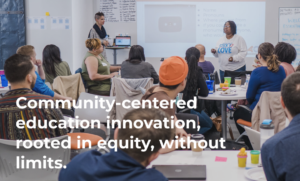Luke Harris on Problem Finding in High School
Key Points
-
When designing, engineers need to spend more time identifying the problem rather than jumping straight to the solution.
-
Schools regularly teach how, but not why. This creates a disconnect for learners.

On this episode of the Getting Smart Podcast, Mason Pashia is joined by a very special guest — Luke Harris. Luke is a Junior at Horace Mann high school and has described himself as “enjoying taking things apart and not quite getting them back together.” For the past two years, he has been developing a design engineering curriculum for kids, created to teach real-world entrepreneurial and engineering skills.
Let’s listen in as they talk about the design process, why problem solving and finding both need to be taught to engineers and much more.
When I look at some engineering examples in the real world, it’s obvious that designers often jumped straight to a solution without truly engaging the problem.
Luke Harris
Also featured in this post is an article written by Luke! Check it out:
We Need to Teach Engineering Right: Here’s How
By Luke Harris
When I took engineering during my freshman year, we focused on building a solution without first examining the problem. We learned how to draw blueprints from all angles and the names of different mechanics such as pulleys, gears, and levers. We ended the year by using shop tools, such as saws and lathes, to make simple mechanical objects and then using those skills to create one large project such as a mini-car or a primitive clock. We learned how to follow instructions to turn an idea into a prototype, and while that’s a useful skill to have, I think engineering is much more than that.
And I recognize that I am one of the luckiest kids in America. My high school has an engineering department. It has equipment and tools that let us complete all sorts of projects, and amazing, dedicated teachers to help us. But we still didn’t focus on solving problems; instead, we focused on executing objects.
When I look at some engineering examples in the real world, it’s obvious designers jumped straight to a solution without truly engaging the problem. A can that changes color when cold is unnecessary: Why can’t people just touch the can to see if it’s cold? Killing sparrows to protect grain creates a grain fiesta for the exploding insect population. A helicopter with an ejector seat is a good idea for getting a pilot out of the helicopter, but only if you don’t care if they’re alive. What all these bad ideas have in common is a misidentification of the problem they were supposed to be fixing. Even as a high school sophomore I could see that. Yet when we teach kids engineering, we skip the problem identification—the tough work around understanding the need—and go right to building a solution.
I was able to see that every product, every device, was a solution to a real-world issue. But that wasn’t being taught in my classes. We were never taught how to conduct interviews or do ethnographic research to figure out the underlying challenges that needed to be tackled. In other words, we were given the tools to solve problems but never taught how to apply them.
I spent lockdown designing a solution, and one that could be used by schools anywhere or homeschoolers without the need for specialized equipment.
Luke Harris
I spend lockdown designing a solution, and one that could be used by schools anywhere or homeschoolers without the need for specialized equipment. My curriculum teaches students how to find problems and how to solve them, including creating prototype products. Not only can schools and after-school programs use it (and have already), but students can go through it on their own time if they want to work independently. The course begins by giving the students a category, for example, beverages, sign postage, desk space, etc. From there, it teaches students how to conduct ethnographic research and asks them to go to a local establishment and figure out what challenges people face. After gathering data, students use problem-solving techniques and design sprints (a method used at design firms) to come up with potential solutions. After further research to see if people like their idea, a final prototype could be crafted in a shop or put together with common household objects, or even just drawn on paper as a start.
As we move into an increasingly robotic and digital age, solving complicated human problems becomes more important than ever. Kids need to be equipped with these skills, and schools need to teach more of the process of entrepreneurship and engineering, including development and research to truly understand user needs. During COVID-19, we gained an opportunity to rethink workplace practices and schooling techniques—let’s do the same with the way we teach engineering. I hope my curriculum is a step on the way to solving that problem.








0 Comments
Leave a Comment
Your email address will not be published. All fields are required.